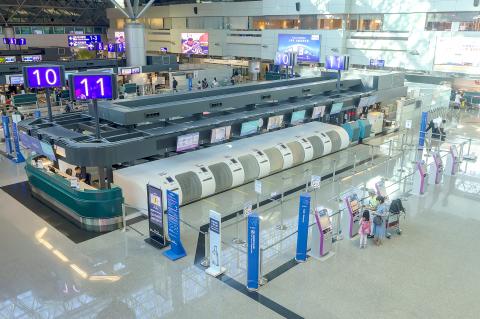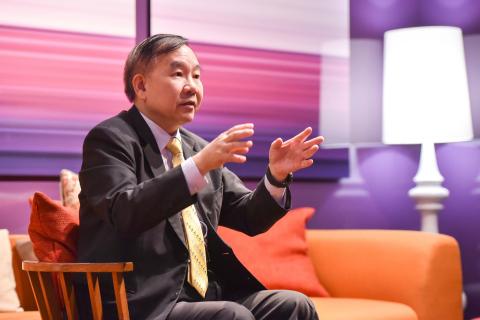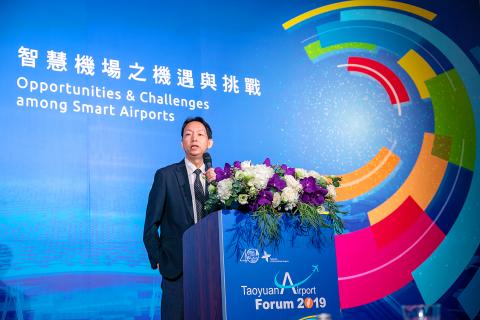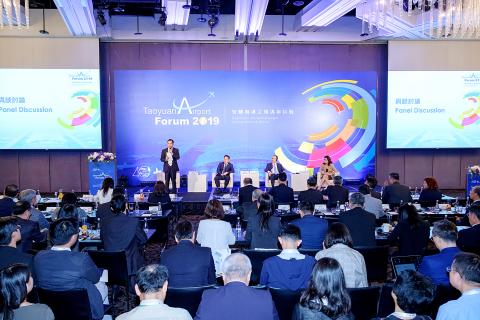On Oct. 17 and Oct. 18, local and international smart technology experts and aviation professionals gathered at Taipei’s W Hotel for the 2019 Taoyuan Airport forum, where they shared their experience and engaged in rich discussion on the theme of “opportunities and challenges among smart airports.” With passenger traffic growing at a fast pace as well as the rapid development of a wide array of smart technologies, transformation opportunities abound to greatly enhance passenger experience and and improve airport operations and management.
Now in its 40th year, Taoyuan International Airport has seen an exponential increase in passenger traffic in the past decade, jumping from 27 million 10 years ago to 46.5 million last year. With the Terminal 3 project still years from completion, Taiwan Taoyuan International Airport Co (TIAC) chairman Wang Ming-teh (王明德), who took the post in January, faces the challenge of relieving the growing congestion while adapting the latest smart airport technologies to further enhance passenger experience and boost airport operations.
“Our hardware is over capacity, so we must continue to strengthen our software,” Wang says. “We cannot turn passengers away, while traffic will continue to increase by about 2 million per year.”

The airport is taking a two-pronged approach to address the issue. The first one is to make use of the latest technology to automate and speed up the processes passengers go through at the airport to reduce congestion and the need for hardware and personnel. This ranges from now-standard self check-in kiosks, self baggage drops and e-gates to cutting-edge smart technologies such as the single-token biometric boarding system that many airports are working toward. Taoyuan International Airport also plans on building Terminal 3’s northern concourse first, with basic but smart facilities that will ease both arrival and departure traffic at Terminal 2.
“We can’t wait until Terminal 3 is completely finished to start using it,” Wang says.
From digitization of physical data to biometrics to 5G networks, artificial intelligence and building information modeling (BIM), speakers at last week’s Taoyuan Airport Forum all raved about the various opportunities and transformations that these technologies bring to the concept of the “smart airport,” which is now a necessity as global passenger traffic is projected to double by 2037, according to the International Air Transport Association (IATA).

Wang and TIAC CEO Lin Hsiang-sheng (林祥生) also spoke at length about their hopes to use these technologies to not just solve the passenger traffic issue, but also augment each visitor’s experience and boost commercial opportunities to create a thriving airport ecosystem where Taoyuan International Airport becomes more than a space where people just rush through in transit. Their visions echo most of the themes that the speakers brought up, hoping to bring Taoyuan International Airport up to speed with the world’s top facilities such as Singapore’s Changi Airport and Hong Kong International Airport.
“Our passenger traffic keeps increasing,” Lin says. “If we keep using traditional operational methods, it will only result in long queues everywhere, and customer satisfaction will drop sharply. A digital transformation is necessary.”
While Terminal 1 and Terminal 2 were built 21 years apart, Wang says airport technology did not change much between that time, and the design and functions of the two facilities are quite similar. While none of this is set in stone as the planning continues and technology develops at breakneck speed, Wang envisions Terminal 3 looking very different than the other two.

“The check-in space will likely be much smaller,” Wang says. “We can use the rest of the space to conduct more business activities.”
Not only will more people be doing online check-ins at home, Wang says the luggage check-in process can be conducted outside of the terminal with a logistics company picking it up from the passenger’s home or hotel, screening it and making sure it gets on the same plane as the passenger. If there is a problem with the luggage, the passenger can be easily identified through smart technology. The same process can be used for arrivals.
Wang was also impressed by Amsterdam Schiphol Airport’s use of CT scanners, which eliminates the need for passengers to remove their shoes or laptops from their bags -- and they can even carry liquids through security checks.

Wang says that boarding passes can potentially be eliminated through biometrics such as facial recognition, as the person’s face becomes a single token that takes the passenger through the entire boarding process, even including duty free shopping. This will greatly simplify the current process, where staff members have to repeatedly check each passenger’s passport and boarding pass up to the point they get on the plane.
Currently, only 13 percent of worldwide travelers use biometrics in the boarding process. But the trend is apparent nearly half of the world’s airports are aiming toward a fully-automated boarding system by 2021. Hong Kong International Airport is among those already in progress toward the single-token concept, trying out automatic identity checks at security gates and boarding gates using facial recognition this year.
An IATA survey shows that 65 percent of travelers are willing to provide personal information to speed up the boarding process, 84 percent are willing to use an automated check-in system and 45 percent are willing to replace their passport with biometric data. The IATA last year launched the One ID initiative toward this purpose, aiming for a “document-free process based on identity management and biometric recognition.” Currently, due to privacy issues, passengers can opt out of the process, and the information will be for one-time use only.
“There may also be older people who don’t know how to use the technology, or rich people who like to be serviced,” Wang says. “So the traditional functions will still exist, but just on a much smaller scale.”
Lin is excited about the potential big data, artificial intelligence, Internet of Things and biometric applications that will be made possible as the airport starts experimenting with a 5G network in the near future. This is what means by “digital transformation,” as the airport can digitize and integrate all its physical and virtual data, from flight information to luggage to the vehicles passengers use to travel to the airport. As everything becomes automated, the instant connectivity that 5G provides is necessary for smart airports to function. When something malfunctions, or if there is an accident, 5G provides instant information so the problem can be fixed immediately.
The airport is working on transforming its air traffic control into a smart system, for example, making things much smoother and efficient for traffic controllers and flight operators. Smart luggage sorting is also being installed, where the staff will be provided with augmented reality glasses to further eliminate errors.
Digitization will also provide more precise and customized navigation for passengers within the terminal through phone applications, and help with marketing and promotion so the passenger can identify and obtain what they need quickly. It can serve as congestion control, guiding passengers toward less crowded gates, for example.
As with the examples Wang brought up, Lin says the ultimate goal is to make the boarding process as short and automated as possible -- just like how passengers rarely need to rely on staff while taking the MRT or High Speed Rail. This way, they have more time to shop and partake in other leisure activities.
“Currently, passengers have very little time to enjoy the commercial services at the airport,” Lin says. “A smart airport saves time for our staff and passengers for they can pass through the checkpoints quickly. They have time to shop, to eat, and this will also lead to more services that will eventually develop into a complete online-to-offline airport ecosystem.”
Simon Lotter, director Asia Pacific of Munich International Airport, also recognizes the overall spending power of airport travelers. As many people prefer to shop online these days, his airport is considering ways to partner with e-commerce giants such as Amazon, and how to enhance the in-airport shopping experience.
Taking it a step further, Lin envisions even more automated services -- the airport already has robots that serve tea and collect used plates, and he mentions the possibility of security robots that can take snapshots of suspicious activity or various malfunctions and use AI to verify if it needs alerting.
According to Vivian Cheung, deputy director of aviation development at the Airport Authority Hong Kong, robots at the airport can perform tasks such as identifying broken lights and wet floors, and even control temperature and humidity as well as deliver meals and documents.
Automated vehicles can not only take people between terminals after hours, but they can also be equipped with smart technology to drive a weary passenger directly to their car at the parking lot, eliminating the need for them to even remember where they parked, Lin says. Hong Kong airport also has automated cars in certain areas that inspect runways and carry luggage.
BIM was one of the main topics of last week’s forum, and Wang mentions it as a potential tool for smart construction and management of the new terminal. BIM essentially is a process that generates digital representations of physical and functional characteristics of a space, making it much simpler to plan, design, construct, operate and maintain the complicated network of functions that keep the airport running smoothly.
Beginning from the designing stage, BIM integrates the various functions so that potential issues and conflicts between experts can be preemptively resolved before construction begins. After it is built, the system provides a record of all the repairs and modifications made after, and can, for example notify airport staff when a certain light is about to expire.
“A big problem is that a lot of this existing information has been lost over the past 40 years,” Wang says.
Wang then brings up the idea of the “digital twin,” where an identical virtual model of the airport can be created. Using the Internet of Things technology, it can simulate and analyze situations and functions without the technicians actually visiting the airport. If something is changed, the digital twin is automatically updated; and airport staff can even directly issue commands through the twin, saving traveling time as airports expand in size.
“This is something for the far future,” Wang says. “But we have to always be looking further ahead.” (Advertorial)

The US dollar was trading at NT$29.7 at 10am today on the Taipei Foreign Exchange, as the New Taiwan dollar gained NT$1.364 from the previous close last week. The NT dollar continued to rise today, after surging 3.07 percent on Friday. After opening at NT$30.91, the NT dollar gained more than NT$1 in just 15 minutes, briefly passing the NT$30 mark. Before the US Department of the Treasury's semi-annual currency report came out, expectations that the NT dollar would keep rising were already building. The NT dollar on Friday closed at NT$31.064, up by NT$0.953 — a 3.07 percent single-day gain. Today,

‘SHORT TERM’: The local currency would likely remain strong in the near term, driven by anticipated US trade pressure, capital inflows and expectations of a US Fed rate cut The US dollar is expected to fall below NT$30 in the near term, as traders anticipate increased pressure from Washington for Taiwan to allow the New Taiwan dollar to appreciate, Cathay United Bank (國泰世華銀行) chief economist Lin Chi-chao (林啟超) said. Following a sharp drop in the greenback against the NT dollar on Friday, Lin told the Central News Agency that the local currency is likely to remain strong in the short term, driven in part by market psychology surrounding anticipated US policy pressure. On Friday, the US dollar fell NT$0.953, or 3.07 percent, closing at NT$31.064 — its lowest level since Jan.

The New Taiwan dollar and Taiwanese stocks surged on signs that trade tensions between the world’s top two economies might start easing and as US tech earnings boosted the outlook of the nation’s semiconductor exports. The NT dollar strengthened as much as 3.8 percent versus the US dollar to 30.815, the biggest intraday gain since January 2011, closing at NT$31.064. The benchmark TAIEX jumped 2.73 percent to outperform the region’s equity gauges. Outlook for global trade improved after China said it is assessing possible trade talks with the US, providing a boost for the nation’s currency and shares. As the NT dollar

The Financial Supervisory Commission (FSC) yesterday met with some of the nation’s largest insurance companies as a skyrocketing New Taiwan dollar piles pressure on their hundreds of billions of dollars in US bond investments. The commission has asked some life insurance firms, among the biggest Asian holders of US debt, to discuss how the rapidly strengthening NT dollar has impacted their operations, people familiar with the matter said. The meeting took place as the NT dollar jumped as much as 5 percent yesterday, its biggest intraday gain in more than three decades. The local currency surged as exporters rushed to